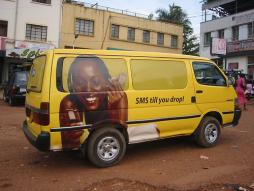Mobile use and prevalence is exploding throughout the developing world. As Tim Kelly writes in id21 insights's September newsletter, in 1990 there were only 14,200 mobiles in Africa, which by, 2005, grew to a total of 137 million. Id21 predicts that the majority of the world's poor will have mobile access within the next generation. This number continues to increase, showing just how important mobile phones have become in development.
In our ongoing series on mobiles in development -- m4dev, as we are calling it, we are pleased to see that id21 focuses its current newsletter on mobiles used in development, with articles profiling mobiles used in countries including Nigeria, Bangladesh, Jamaica, and Zambia.
Our wonderful colleague Abiodun Jagen writes about mobiles used in the informal sector in Nigeria. Jagun cites a study of the Aso Oke textile industry, showing how mobiles have filled information gaps allowing merchants to increase trade, improve communication, and shorten time to fill orders. Although in some ways mobile phones have worked successfully as an equalizer, Jagen also mentions that a "mobile divide" still exists -- merchants who have mobiles receive many more orders than those who don't, further widening the income gap.
Jonathan Donner's piece on mobile banking explores the success that m-banking has had in the developing world, specifically mentioning programs in South Africa, the Philippines, and Kenya targeting poor people.
What he does not mention is that although mobile banking for the poor has shown to be tremendously successful in many places, there is some evidence that is is less helpful to those at the very bottom of the pyramid. According to a study sponsored by the UN, Vodaphone, and the Consultative Group to Assist the Poor (CGAP), this was consistently true of the customers of WIZZIT, a mobile phone banking company in South Africa. The study notes that, "many WIZZIT customers are indeed poor, but they are not among South Africa’s poorest people. They tend to have more income and assets and be more financially and technologically sophisticated than other low-income South Africans." More research is needed to determine how to better target this segment of the population.
One aspect of m-banking that perhaps Donner neglects is that of remittances. As Christine Bowers writes on the Foreign Policy blog, remittances may be where m-banking is most successful in helping those at the bottom of the pyramid:
Remittances is where m-banking will really be world-changing. In Latin America, for instance, fewer than 10 percent of remittance recipients have bank accounts. That means they're hiking to Western Union to pick up their money, which cost somebody a 15 percent commission to send. In the Philippines, SMART's customers are already sending an estimated $50 million in remittances each month via their mobile phones, and that's only the tip of the iceberg. In most of the world, remittances account for more financial flows than foreign direct investment or foreign aid combined. Lowering transaction costs even one percent would mean over one billion extra dollars would directly reach the poor each year, and that's not chump change.
Ananya Raihan writes about the "Mobile Ladies" in Bangladesh, who link villagers to the D.Net Rural Information Helpline. This service can answer questions about health, agriculture, human rights, and other issues. The "Mobile Ladies" go door to door with mobiles in hand, helping the villagers to answer their questions or calling the helpline when necessary. Raihan writes that the helpline has been instrumental not only in providing information to rural villages, but in creating a profession for women. He says, "Mobile Ladies is a profession for women in even the most remote villages and the project could ultimately lead to employment of about 89,000 women."
MobileActive is mentioned for our reporting on systematic election monitoring via mobile phone, most recently in Sierra Leone. The article mentions the use of sousveillance, or the practice of citizens monitoring the state, that has been made possible by mobiles.
Kutoma Wakunuma discusses a study on mobiles and gender relations in Zambia. She writes that although mobile phones can have huge advantages for women, they have also reinforced some traditional gender power structures. She cites examples of a man who beat his wife after she refused to let him look at her text messages and men who force their wives to only make or receive calls in their presence. Wakunuma says there are even popular songs that have lyrics discussing the problems mobiles have caused between men and women. This is particularly interesting, given that mobiles have been shown to increase gender equality, giving women more economic independence, protections from domestic violence, and greater access to information. Wakunuma writes,
"Those promoting and making policies for mobile phones must understand that these new technologies create problems as well as solutions. These problems must be recognised if they are to be addressed. Among other things, this will require much greater gender awareness in policies and projects.
There is a lot of very valuable content in the newsletter with its collection of articles. We will follow up tomorrow with a guest post by one of the contributors, Abiodun Jagun, who cautions MobileActive readers that while phones are helpful in development, mobiles aren't a panacea and create a collection of problems of their own.
Photo credit to futureatlas.com.


Post new comment